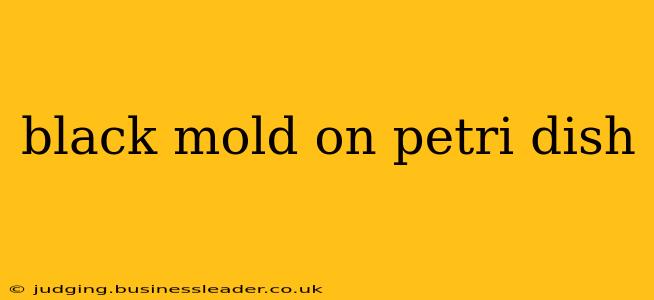Black mold, a common term for various dark-colored fungi, can sometimes appear on petri dishes used in scientific experiments or even in improperly stored food. While the sight of black mold can be alarming, understanding its implications and how to handle it is crucial. This article will explore the identification of black mold on a petri dish, preventative measures, and the safety protocols necessary to mitigate potential risks.
What Kind of Mold Is Growing on My Petri Dish?
Identifying the specific type of mold requires microscopic analysis and often, specialized laboratory techniques. Simply seeing black mold doesn't tell you the species. Many different fungi can produce black spores or colonies. Some are harmless, others potentially pathogenic. Therefore, never attempt to identify the mold solely based on its visual appearance.
Is Black Mold on a Petri Dish Dangerous?
The danger posed by black mold on a petri dish depends entirely on the species of mold. Some black molds are relatively harmless, while others can produce mycotoxins—toxic substances that can cause health issues ranging from allergic reactions (skin irritation, respiratory problems) to more severe conditions in immunocompromised individuals. The risk also depends on the exposure level. Brief exposure to a small amount of harmless mold is unlikely to cause problems, while prolonged or intense exposure to a toxic mold could be harmful.
How Can I Prevent Mold Growth on Petri Dishes?
Preventing mold growth is paramount in maintaining the integrity of experiments and preventing potential health hazards. Here are some key strategies:
- Sterile Techniques: Maintain strict aseptic techniques during the preparation and handling of petri dishes. This includes sterilizing all equipment and working in a clean environment.
- Proper Storage: Store petri dishes properly, ideally in a cool, dry, and dark environment. This inhibits fungal growth.
- Appropriate Media: Use sterile culture media and ensure proper preparation to minimize the risk of contamination.
- Regular Inspection: Regularly inspect petri dishes for any signs of mold growth. Early detection allows for prompt action.
What Should I Do If I Find Black Mold on a Petri Dish?
If you discover black mold on a petri dish, take the following steps:
- Do not open or disturb the petri dish. This prevents the release of spores into the environment.
- Wear appropriate personal protective equipment (PPE). This should include gloves, a lab coat, and possibly a mask depending on your assessment of the risk and your institution's safety guidelines.
- Dispose of the petri dish properly. Follow your institution's guidelines for biohazard waste disposal. Typically, this involves autoclaving (sterilizing under high pressure and temperature) before discarding the contaminated dish.
What are the Common Causes of Mold Growth in Petri Dishes?
Mold contamination in petri dishes often stems from:
- Contaminated media: Using non-sterile media is a primary cause.
- Poor aseptic technique: Improper sterilization of equipment or work surfaces.
- Environmental contamination: Dust, airborne spores, or other contaminants entering the workspace.
- Improper storage: Storing dishes in humid or warm environments.
How can I identify the specific type of black mold?
Identifying the exact species of mold requires laboratory analysis by trained professionals using techniques like microscopic examination and possibly DNA sequencing.
Is it safe to touch black mold on a petri dish?
It's best to assume that any mold, especially black mold, is potentially harmful and avoid direct contact. Always wear appropriate PPE before handling any potentially contaminated petri dish.
Can black mold on a petri dish affect my health?
The impact on health depends on the type of mold and the level of exposure. Some molds produce toxins that can trigger allergies or other health problems, especially in people with pre-existing respiratory conditions or weakened immune systems.
This information is for educational purposes only and should not be considered medical or scientific advice. Always consult with a qualified professional for any concerns about mold or other health issues. Remember to prioritize safety and follow appropriate disposal procedures when dealing with potentially contaminated materials.
